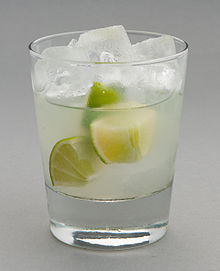Caipirinha
| IBA Official Cocktail | |
|---|---|
 |
|
| Studio photo of a caipirinha | |
| Type | Cocktail |
| Primary alcohol by volume | |
| Served | On the rocks; poured over ice |
| Standard garnish |
sugar cane, lime(ingredient) |
| Standard drinkware | Old Fashioned glass |
| IBA specified ingredients* | |
| Preparation | Place lime and sugar into old fashioned glass and muddle (mash the two ingredients together using a muddler or a wooden spoon). Fill the glass with crushed ice and add the Cachaça. |
| Notes | A wide variety of fresh fruits can be used in place of lime. In the absence of cachaça, vodka can be used, making a caipiroska. |
| * Caipirinha recipe at International Bartenders Association | |
sugar cane, lime(ingredient)
Caipirinha (Portuguese pronunciation: [kajpiˈɾĩj̃ɐ]) is Brazil's national cocktail, made with cachaça (pronounced: [kaˈʃasɐ]) (sugarcane hard liquor), sugar and lime. Cachaça, also known as pinga, caninha, or any one of a multitude of traditional names, is Brazil's most common distilled alcoholic beverage. Although both rum and cachaça are made from sugarcane-derived products, in cachaça the alcohol results from the fermentation of fresh sugarcane juice that is then distilled, while rum is usually made from refinery by-products such as molasses.
The drink is prepared by muddling the fruit and the sugar together, and adding the liquor. This can be made into a single glass, usually large, that can be shared amongst people, or into a larger jar, from where it is served in individual glasses.
Although the real origins of caipirinha, as it is known today, are unknown, according to one account it began around 1918 in the state of São Paulo with a popular recipe made with lime, garlic and honey, indicated for patients with the Spanish flu. Today it is still being used as a remedy for the common cold. As it was quite common to add some distilled spirits to home remedies, in order to expedite the therapeutic effect, rum was commonly used. "Until one day someone decided to remove the garlic and honey. Then added a few tablespoons sugar to reduce the acidity of lime. The ice came next, to ward off the heat," explains Carlos Lima, executive director of IBRAC (Brazilian Institute of Cachaça).
...
Wikipedia

